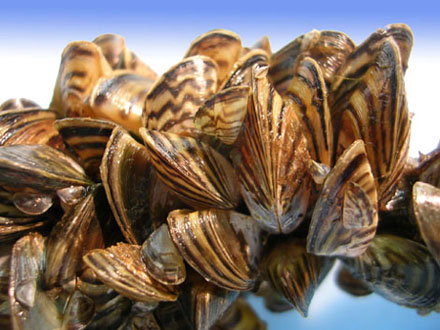Effects of Zebra Mussels on Reservoir Aquatic Communities
Investigators: 
Andrea Severson, M.S. student
Dr. Craig Paukert
Project Supervisor:
Dr. Craig Paukert
Funding:
Kansas State University
Kansas Department of Wildlife
Parks and Tourism
Location:
El Dorado, Melvern
Hillsdale reservoirs in eastern Kansas
Cooperators:
Kansas Department of Wildlife
Parks and Tourism
Completion:
May 2010
Objectives:
Determine if zooplankton abundance differed before and after zebra mussel establishment, and if these trends were similar to reservoirs without zebra mussels.
Determine if age-0 largemouth bass growth differed before and after zebra mussel establishment, and if these trends were similar to reservoirs without zebra mussels.
Progress and Results:
In August 2003, zebra mussels were discovered in El Dorado Reservoir, Kansas and are currently at densities of up to 65,000/m2 (J. Goeckler, Kansas Department of Wildlife and Parks [KDWP] personal communication). This study will provide evidence on the effects of zebra mussels on reservoir centrarchid abundance and largemouth bass growth. In 2003, zebra mussels were found in El Dorado Reservoir, but they have not been found in nearby Melvern or Hillsdale reservoirs. This study will evaluate age-0 largemouth bass growth, fish abundance, and zooplankton abundance prior to establishment of zebra mussels (2001-2002) and five years after establishment (2008-2009) in El Dorado Reservoir. In addition, non zebra mussel infected reservoirs will be sampled to use as controls so we can more clearly identify if growth and abundance patterns are from zebra mussels or are consistent with lakes without zebra mussels. A study funded by KDWP from 2001-2004 sampled age-0 centrarchid abundance, age-0 largemouth bass growth, and zooplankton abundance in coves in El Dorado, Melvern, and Hillsdale reservoirs and will be used as comparisons of fish growth and zooplankton abundance 5 years after zebra mussel establishment.
Products:
Severson, Andrea (M.S. 2010; advisor Paukert). Effects of zebra mussel (Dreossena polymorpha) invasion on the aquatic community of a Great Plains reservoir. Kansas State University.
Paukert, C. and A. Severson. 2010. Zooplankton community characteristics in El Dorado Reservoir: response to zebra mussel invasion. Kansas Natural Resources Conference, Wichita, KS.
Severson, A. and C. Paukert. 2010. Zooplankton community response to zebra mussel invasion in a Kansas reservoir. Midwest Fisheries Student Colloquium, Manhattan, KS.